Seeds on Ice: Preserving the World’s Agricultural Heritage
Air Date: Week of August 25, 2017
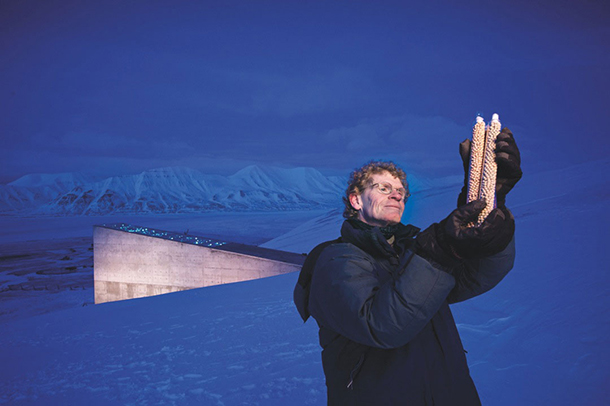
Cary Fowler led the effort to create the Svalbard Global Seed Vault (Photo: Mari Tefre)
Deep in an icy mountain not far from the North Pole are rows upon rows of boxes filled with seeds -- nearly a million samples gathered from nations collections around the globe. Cary Fowler is a founder of the Svalbard Global Seed Vault and the author of the new book documenting its story and its treasures called Seeds on Ice. He joins Living on Earth’s Helen Palmer to explain why humanity needs a seed vault at the top of the world to ensure the genetic diversity of our agricultural heritage.
Transcript
CURWOOD: Time now to dive into a breathtaking and beautiful book that chronicles a profound and visionary investment of hope. It’s called Seeds on Ice. There are not many words but plenty of pictures that explain the thinking and work that created the Global Seed Vault at Svalbard, Norway. Author Cary Fowler spoke with Living on Earth’s Helen Palmer.
PALMER: Cary Fowler, you are the father of the Global Seed Vault. First of all, tell me what exactly this global seed vault is.
FOWLER: The Global Seed Vault – the Svalbard Global Seed Vault – is a backup insurance policy for all the seed banks around the world, and the idea is that we want to provide failsafe protection for the diversity of our agricultural crops, diversity that is stored in the form of seeds. You need cold temperatures, freezing temperatures, to conserve seeds long term. So we went close to the North Pole where it's very cold, and we built a facility inside of a mountain, which makes it also very secure, and there we're storing backup copies, seed samples of currently more than 850,000 different crop varieties.
PALMER: They are already national collections, as you've said, and seed vaults. Why do we need a backup?

The photographs in Seeds on Ice: Svalbard and the Global Seed Vault are by Mari Tefre. (Photo: Mari Tefre)
FOWLER: We need a backup because bad things happen to seed banks, and there's so many examples of this that are catastrophic at a local or national level. There's been a fire and a flood inside the Philippine national gene bank, the Iraqi and Afghanistani gene banks were destroyed or at least very much harmed by the wars there. Seed banks in a way are a little bit like libraries and every once a while something bad happens to an individual book in a library and, likewise, even in a really great seed bank something bad will happen to a particular sample just by accident or mismanagement. And every time something bad happens like that, we lose that variety. In other words, it's an extinction event. We don't talk about saving a representative sample of Rembrandts and Goyas. We would like to save them all and ditto with agricultural plant diversity. We want to save all of that diversity. They’re all treasures.
PALMER: You point out that Norway is the ideal country, both to host this and indeed has the ideal place to put it, and indeed is accepted by the international community as an honest broker. Why is that so?
FOWLER: Norway has always played a really positive role in international discussions and debates frankly about how to conserve this material and how to exchange it between countries. It's a fairly contentious issue, believe it or not, and countries are formulating rules about how to and under what circumstances and conditions to exchange crop diversity. No country on Earth has the requisite amount of crop diversity to fuel their own plant breeding programs into the future and that includes the United States. So, every country on Earth is dependent on other countries, or interdependent with the globe, to secure the biological foundation of its own agricultural system. So Norway's played a great positive role in that and Norway provided the perfect conditions and not coincidentally, it also provided the funding for it, and we needed that.
PALMER: So tell me about Svalbard. Where is it and what is it exactly?
FOWLER: Svalbard is a group of islands, and if you look at a map, or you have a globe handy you go to the North Pole and look just a little bit southward. So if you were in Oslo, Norway, which most people think of as far north, you would need to fly about 1,300 miles north of there to get to Svalbard. The seed vault itself is located at 78 degrees North and it's the farthest North that you can fly on a regularly scheduled airplane, albeit only about once a day, and it's a remarkably beautiful exotic otherworldly place. It can snow on any day of the year. This is an area that’s twice the size of Belgium and about 60 percent covered with glaciers. Still, great infrastructure, very safe, secure. It was just the ideal location.
PALMER: It has to be said we're in an era of global warming. How safe is Svalbard for global warming? I mean, we hear about glaciers melting all over.
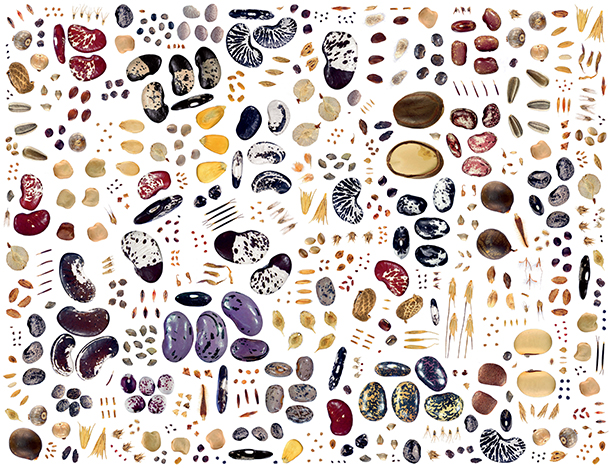
The seed vault contains more than a half billion seeds. (Photo: Mari Tefre)
FOWLER: Oh yes, well, Svalbard is not safe from global warming, no place on Earth is, but the idea with the seed vault and with all the good seed banks around the world is that you want to freeze the seed down to about minus three or four Fahrenheit, minus 18 Celsius and there's no place on Earth where you can do that naturally without mechanical cooling. So the challenge then is simply to find a place that gives you naturally cold temperatures, as cold as you can get, and from there you have to lower it a little bit further. So that's what we have in Svalbard, and the permafrost, we've built a tunnel that goes 130 meters into the mountain. It's a bit below freezing there. It's about minus five Celsius, and so even at that temperature, if our mechanical freezing were to fail, it would take months and months and months for that facility to warm up to something still below freezing, and even at that rate we calculate the seeds would be safe for decades. So we’d have a long time to fix the problem.
PALMER: There's one kind of irony and that is that the cooling that you have in the vault is actually powered by coal, and one of problems we've got of course, is global warming, and coal is one of the dirtiest fossil fuels we’ve got. Has this ever come up as an issue?
FOWLER: Well, we have to power the facility in some way. It doesn't take much. We don't have a big electricity bill, and there is a village up there that has to be powered and electrified, of course, and coal is local, it's locally mined. So, you know, we're not shipping oil over the ocean to power that facility, and in a place like that where you have three months of polar night every year, it would be pretty hard to run it solar.
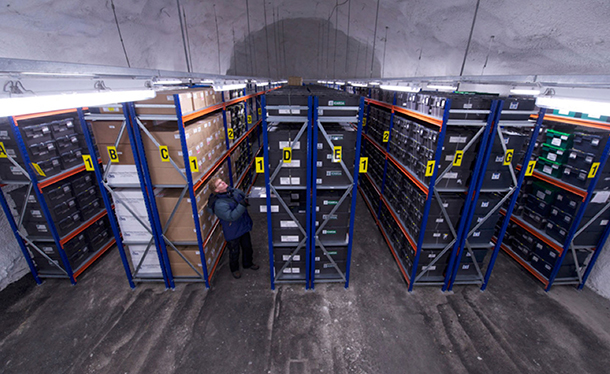
The vault houses more than 860,000 seed samples packed in boxes placed on shelves. Each sample packet contains 500 seeds. (Photo: Jim Richardson)
PALMER: I've looked at the pictures in the book and they are stunning. I mean, it's very bleak and large and colorful and lots of northern lights, and lots of polar bears and not many people.
FOWLER: That's true. There are, I think, more polar bears than people and certainly more reindeer up there than people, and when you're up there particularly if you leave the little village you will have I think an emotional experience that few people on Earth have these days, and that's an experience that comes from being untethered to civilization, and you realize you're really out there, you get a pretty profound feeling that you're on your own and that nature is in control and that nature is a little bit bigger and more powerful than we are individually. It'll have quite an impact on you.
PALMER: So you’ve got this vault at the end of a 300 foot tunnel more or less. What exactly is it? What does it consist of?
FOWLER: At the end of the tunnel we have three vault rooms, and each vault room is, well, about 30 meters long, 10 meters wide and five meters high, and we're only storing seeds in one of those vault rooms. Everything about the seed vault has a lot of built in redundancy, so I did some calculations about how much space we would need to store all of the agricultural seed diversity in the world, and we have about three times as much storage space as my estimates indicated we would need because, well, I could be wrong. And when you walk into this final chamber it's extremely cold and it looks a little bit like a warehouse, frankly. We have shelves and we have boxes in the shelves, and each box contains about 400, 500 seed samples.

There are three main tunnels within the Svalbard Global Seed Vault (Photo: Mari Tefre)
They're all in individual packets, about 500 seats per packet, so currently I think we have about 500 million seeds down there, quite a few tons. And the boxes, they're pretty. They come from countries all over the world, and they have their little insignias on it, and when you walk down the aisles, you have to walk down the aisles with some humility because what you're seeing is the results of agricultural evolution over the last 15,000 years. It's essentially a biological history of agriculture, but it's also everything that agriculture could be in the future is represented in that diversity.
PALMER: Has every country bought into the idea of the need to preserve this seed heritage?
FOWLER: Well, the seed vault has seeds that are sourced from just about every country in the world including some countries that no longer exist, but that doesn't mean that every institution in every country has participated yet, and I think eventually they will. One of the other aspects of the management plan that we had to work out was a question about property rights. Who owns these seeds? So the way that we set up the seed vault was it would function like a safety deposit box at the bank where Norway owns the facility itself. In other words, it owns the mountain, but the individual depositor would own their seed deposits themselves and they and only they would have access to those seed deposit. So we don't send the United States collection to Canada or vice versa or whatever, but some countries simply take longer than others to come around to that that idea had to work through the bureaucracy so I'm not too worried about that, but I think we have a fairly good sample of the diversity in the world. I mean, we're looking at more than 150,000 different types of rice, and more than 150,000 different kinds of wheat and I think about 35,000 different bean varieties and on and on.
PALMER: So why do you need 150,000 varieties of wheat or rice?
FOWLER: We need that kind of diversity because we don't have a crystal ball about what the future will bring. We know that there are always surprises, that agricultural crops they're evolving as are the pests and diseases that strike them. And with global warming, we're seeing the natural range of pest and diseases change and so new assemblages of species are coming into being and we don't know how crops are going to react to that, and human beings change their tastes and the food industry changes its requirements over time and all of that means that we need different traits, and so this diversity is a little bit like an artist’s palette. We want as many colors as possible so that we can create new paintings and every time you take away a color, every time you take away diversity you limit your options and there have been cases in our lifetime where we've had to search the entire collection of a particular crop and have only been able to find one variety containing particular genes, in other words, traits, that are needed to essentially rescue the crop.

Different varieties of wheat are stored in the Svalbard Global Seed Vault. (Photo: Marc Di Luzio, Flickr CC BY 2.0)
PALMER: Some people would argue that science has been able to breed new varieties. You don't think science could just be the answer here? You think we need nature?
FOWLER: Oh, I love science and I have a lot of respect for it, and this diversity is used by scientists every day both in basic biological research but also traditional plant breeding. But we're not gods and not only are the individual genes, traits, important but I think we're, in the future we're going to learn a lot and benefit a lot from understanding the combinations of traits that have been assembled by our ancestors. Our diverse...our old heirloom varieties of grains and fruits and vegetables and such are the result of countless evolutionary experiments and they are the successful results of those experiments. So we have much to learn and I don't think we're going to have a substitute for this diversity anytime soon.
PALMER: How much genetic variety have we actually lost?
FOWLER: I don't know how much variety or diversity we've lost because frankly we never had a headcount on it to begin with. We do have some records, at least in reasonably modern times. If you go back to the 1800s, the US Department of Agriculture was essentially doing a census of the varieties of fruits and vegetables that were grown by American farmers and we know we've lost a great deal of those varieties. I would make a distinction that varieties and diversity aren't quite the same thing because you can have a trait that appears in more than one variety of apple, for example. So losing a variety of apple doesn't mean you've lost that trait necessarily, but in some cases of course it would.
PALMER: Are you still collecting? Are there any other seeds you would really like to get?
FOWLER: Absolutely. There's always more diversity out there. Diversity is cropping up all the time so this task will never really end. We would like to get more of the wild relatives of our domesticated crops, they're pretty tough plants and in a situation where the weather is bad or there's global warming, those kind of traits are really interesting and useful for agriculture. Some of the very minor crops, we don't have good collections of some of those so I'd like to add to those, and there are a few countries that haven't participated in the seed vault yet. It doesn't mean that we don't seeds that were collected by other institutions in those countries, but we don't have those country’s collections as well so we want to add China and India and Ethiopia, Iran, to that list, of course.
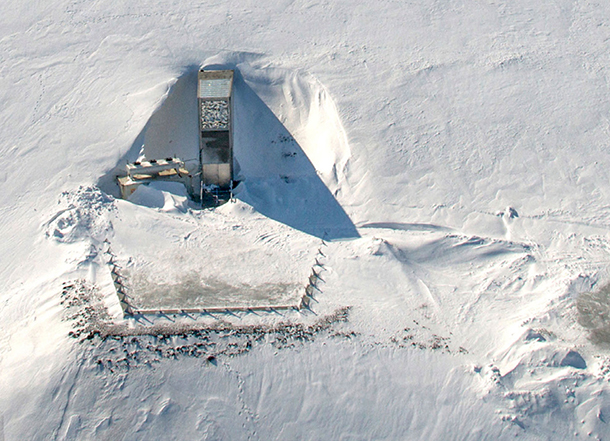
The seed vault is tucked into a frozen mountainside on the Svalbard archipelago. (Photo: Mari Tefre)
PALMER: When you say minor crops, what are you talking about?
FOWLER: Some of the vegetables, for instance, there's a whole category of African leafy vegetables. There are minor crops that you probably never would've heard of, I mean, Bastard Cabbage and Mormon tea and Love Lies Bleeding and Cheesy Toes, maybe these are forage crops but these are exotic names and I don't really know much about those as well, but we could use some more diversity of things like that.
PALMER: How long will the seeds stay viable in the vault?
FOWLER: It depends on the species. At the short end, some species would be fine for maybe 7,500 years or more. Our major grain crops, if you look at rice or wheat, barley, those should be viable somewhere between one and 2,000 years from now. Sorghum we estimate would be viable more than 19,000 years from now. Having said that I would add that this is not a time capsule, so yes eventually, even if eventually is 2,000 years from now, the seed will lose its ability to germinate. But what we've tried to do with the seed vault is to establish a facility whose conservation standards are equal to or better than any of the depositing institutions. So, in other words, the seeds in the seed vault will decline in their germinability no more quickly than those in in the best seed banks around the world and those seed banks monitor their seed supplies all the time so when they see that a seed sample is declining in its viability, they will take some seats outgrow them in the real world, multiply them and when they do that they'll send more seed to the seed vault. It's a living facility and will always have seed coming in.
PALMER: So it's constantly being replaced as it were. Does it also work as a kind of lending library of seeds?
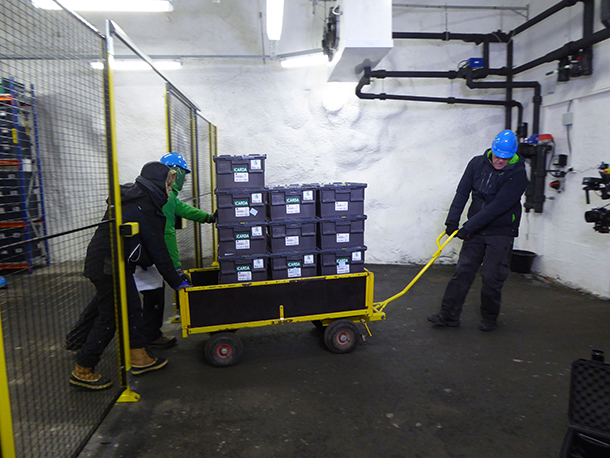
In 2015, the International Center for Agricultural Research in the Dry Areas (ICARDA) became the first seed bank to withdraw seeds from the Svalbard Global Seed Vault. Conflict in Aleppo, Syria forced the organization from its facility there. (Photo: Norwegian Ministry of Agriculture and Food, Flickr CC BY-ND 2.0)
FOWLER: That's a good analogy. It is a library but the lending library portion of it really is up to the depositing institutions. It's pretty impractical to go to the North Pole or Svalbard to get seeds if you need them for a research project or plant breeding, so you would go to the normal national seed bank or one of the international research centers to get the seeds directly there. This is the backup, this is the insurance policy for all of those, but mostly we built the facility not thinking about doomsday or anything like that. That word doesn't appear in any of the planning documents. We built it because doomsday really occurs on an almost daily basis and one of the hundreds of seed banks around the world where they're losing a sample here and there, and that might be the sample that not just that country but all of humanity needs for that particular crop. By the way, we have had our first withdrawal of seeds and that was both a sad and a happy occasion. It was sad that the withdrawal needed to take place. It was happy that we had the backup copy so the collection in question wasn't lost.
PALMER: So, who needed to withdraw seeds?
FOWLER: There was a wonderful international institution located outside of Aleppo, Syria, with the acronym ICARDA, the International Center for Agricultural Research in Dry Areas. This was not a Syrian facility, this was an international facility and they specialized in conserving and breeding wheat, barley, lentils, chickpea and a wonderful crop called grasspea or Latherous, major suppliers for farmers in that region particularly working on drought tolerant varieties which are of course very important and food security in the Mideast is of global importance.
So when the war came to Syria the researchers had to abandon their research station, but fortunately we had anticipated that there might be a problem then we worked with that institute to get a spare copy of all their seed samples out of Syria and up to the Svalbard Global Seed Vault before the fighting really started, and they reestablished their center in Morocco and Lebanon and of course they don't have access to the seed bank in Syria any more so they really needed to start to get their seed supplies back and we shipped them back in September 2015, and they will multiply those seeds and they'll start to use them again in their own research project and then as you can imagine they will be rather highly motivated to send us a copy back again.
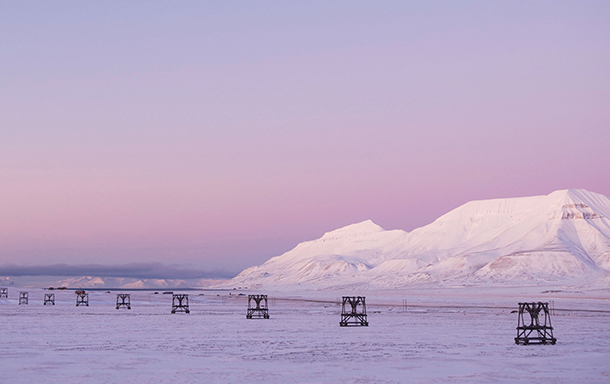
Old coal transport infrastructure contrasts with the ice and snow of the mountains near the town of Longyearbyen, Norway. Coal is plentiful in the Svalbard archipelago and powers the seed vault. (Photo: Mari Tefre)
CURWOOD: That's Cary Fowler, author of "Seeds on Ice: Svalbard and the Global Seed Vault" talking with Living on Earth's Helen Palmer. Cary Fowler insists Svalbard is not a Doomsday Vault – and though there was a scare in October of 2016 when usually heavy rains and high temperatures resulted in meltwater leaked into the outer tunnel, the Norwegian Government says none of the seeds were ever at risk.
Links
Seeds on Ice: Svalbard and the Global Seed Vault
More about the Svalbard Global Seed Vault
CNN: About ICARDA’s withdrawal of seeds following its move from Aleppo, Syria
Living on Earth wants to hear from you!
Living on Earth
62 Calef Highway, Suite 212
Lee, NH 03861
Telephone: 617-287-4121
E-mail: comments@loe.org
Newsletter [Click here]
Donate to Living on Earth!
Living on Earth is an independent media program and relies entirely on contributions from listeners and institutions supporting public service. Please donate now to preserve an independent environmental voice.
NewsletterLiving on Earth offers a weekly delivery of the show's rundown to your mailbox. Sign up for our newsletter today!
 Sailors For The Sea: Be the change you want to sea.
Sailors For The Sea: Be the change you want to sea.
 The Grantham Foundation for the Protection of the Environment: Committed to protecting and improving the health of the global environment.
The Grantham Foundation for the Protection of the Environment: Committed to protecting and improving the health of the global environment.
 Contribute to Living on Earth and receive, as our gift to you, an archival print of one of Mark Seth Lender's extraordinary wildlife photographs. Follow the link to see Mark's current collection of photographs.
Contribute to Living on Earth and receive, as our gift to you, an archival print of one of Mark Seth Lender's extraordinary wildlife photographs. Follow the link to see Mark's current collection of photographs.
 Buy a signed copy of Mark Seth Lender's book Smeagull the Seagull & support Living on Earth
Buy a signed copy of Mark Seth Lender's book Smeagull the Seagull & support Living on Earth

